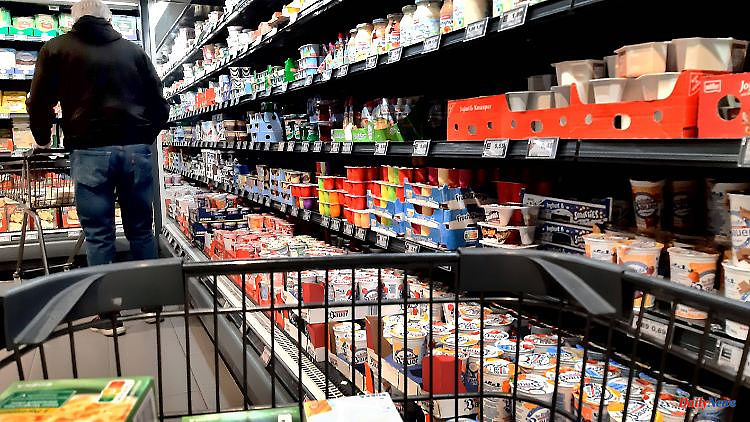The inflation rate has known only one direction for months: upwards. Consumer prices are rising faster and faster, in October by 10.4 percent compared to the same month last year. Germany had not recorded such a high inflation rate for more than 70 years. In the meantime, however, there are increasing signs that the peak in inflation dynamics, if not yet reached, is at least in sight. An overview:
The oil price falls
The main drivers of prices this year were the high energy costs. Oil, as the world's most important source of energy, plays a decisive role in this. The world market price for crude oil has been falling for several months now and is now back below the level at the time of the Russian invasion of Ukraine. Wholesale gas prices have also fallen by around two-thirds since the record highs in the summer.
The euro is stabilizing
The weakness of the European currency also contributed to the high price increases. For example, she helped ensure that fuel prices in Germany rose even more than oil prices, which are quoted in US dollars. After the euro fell from around 1.13 US dollars at the beginning of the year to a low of under 96 US cents in September, making imports significantly more expensive, the common currency has now recovered slightly, meaning that imported goods are tending to become cheaper again.
Normalization on the world seas
Many consumer goods, from electronic devices to flowerpots and bicycles, but also preliminary products for German industry, had become more expensive because they suddenly became scarce. Because the ship transport, especially from Asia, had almost collapsed at times. The prices for containers, some of which were delayed for months, had multiplied. However, the situation on the world's oceans and in most ports has now largely returned to normal. According to the Institute for the World Economy, for the first time in over a year less than ten percent of the goods on global trade routes are stuck in traffic jams, i.e. on ships that cannot continue, for example because there is no space available in the port of destination. The costs for container transport have fallen by more than 80 percent from their peak.
Producer prices fall
While inflation, which measures the increase in consumer prices, has risen sharply recently, the prices that producers charge for their products "ex factory gate" have already fallen in October compared to September. This will not be immediately reflected in falling consumer prices. Until now, many producers and traders had not yet fully passed on their increased costs to the end consumer. Therefore, many of them are planning price increases in the coming months. Due to falling producer prices, these upcoming increases - and thus the inflation rate - could be lower than in the past few months. Not all producer prices have fallen. In the case of food in particular, there have been significant increases until recently. Since these have a smaller share in the basket of goods on which inflation measurement is based than energy costs, for example, the development should have a positive effect on balance.
relief measures come
According to the current plans of the traffic light coalition, companies and consumers are to be supported in the coming year by gas, district heating and electricity price brakes. While the price cap for 80 percent of private household consumption will be relieved from March (then retrospectively also for January and February), the industry will receive the financial aid from January. This in turn could lower producer prices and thus indirectly lower consumer prices. Overall, economists are assuming that the federal government's relief package - depending on the design of a few details that are still open - could reduce the inflation rate by several percentage points.
There is no wage price spiral
Recently, the collective bargaining parties in some sectors have negotiated substantial wage increases compared to previous years. So far, however, most wage increases have lagged behind inflation. The agreement of partly tax-privileged one-off payments instead of permanent wage increases means that companies are not faced with permanently increasing costs. The feared spiral of rising wage costs, causing companies to raise prices, which in turn would cause workers to increase their wage demands. Whether and how exactly this mechanism takes place in reality is a matter of debate among economists. It is clear, however, that such a feared wage price spiral is currently not to be observed in Germany.
The ECB is changing course - too late
A few months ago, the European Central Bank ended its years of zero or negative interest rate policy. Raising interest rates is intended to encourage banks to raise lending rates, making investment more difficult and reducing demand for goods and services. Less demand, in turn, has a dampening effect on prices. However, critics keep arguing that inflation in Europe is currently not due to overheated demand, but primarily to supply restrictions caused by the war and the crisis. The central bank has no direct influence on this with its instruments. Economists assume that interest rate hikes by the central bank will only be reflected in the inflation rate after several months to two years. This means that in the worst-case scenario, the ECB's current decisions will only take full effect when inflation has already fallen for other reasons and loose monetary policy would be appropriate again to stimulate the economy.
China's Lockdowns
China's drastic corona measures have affected prices in Germany in several ways. On the one hand, lockdowns and business disruptions in both factories and key ports have contributed to shortages and price hikes for many commodities. Since the leadership in Beijing has fundamentally adhered to this zero-Covid policy to this day, this effect cannot be ruled out in the future. On the other hand, these measures weakened the Chinese economy to such an extent that global demand for energy and global raw materials, including their prices, was severely curbed.
Risks for price jumps
Some of the effects described can be expected to continue and dampen inflation in the coming year. But that is by no means certain. In the case of energy prices in particular, surprises are more the rule than the exception. The European gas supply, which currently seems secure, is hanging by a thread. Minor disruptions in gas supplies from one or two supplying countries could push prices back up. If China's recently faltering economy regains momentum, commodity and energy prices could rise again as demand rises.












